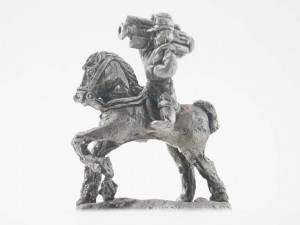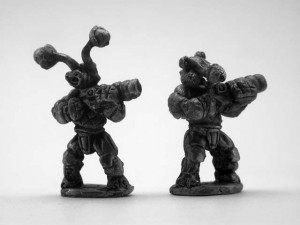Time for the next installment of the Tony Bath Compendium …
CHESSBOARD WAR
by
Tony Bath
The War Game Digest Book V Volume III, September 1961
Battleground: a sheet of board 3′ x 3′ divided up into 2″ squares.
Initial layout: each player sets out his army on his own side of the board. Any lay-out may be used, but his front line may not be more than 7 squares forward from the base—line.
Moves: The players toss for first move, and then move alternately. At each move one piece may be moved — infantry 1 square, cavalry 2 squares. Moves may be made in any direction, forwards, backwards, sideways or diagonally, but cavalry must move 2 squares and in a straight line. Two pieces may not occupy the same square, but cavalry may jump over a square occupied by one of their own pieces. They cannot jump over opposing pieces.
Combat: Individual combat results when one player moves a piece into a square already occupied by an enemy soldier. The attacking player then throws 2 dice. In equal combat (i.e. infantry v infantry or cavalry v cavalry) he must throw a six to kill the opposing piece; if a horseman attacks a foot soldier he kills him with a throw of 4 or higher. If the required number is not thrown, the defending player then throws: if he can beat the other’s throw then the attacking soldier is slain, but if he fails to beat it he must retire his piece one move. If no square is open for this retirement the man is captured. All dead or captured pieces are removed from the board. A soldier who has slain his opponent in hand to hand may make an additional move.
Missile Weapons: Any troops possessing missile weapons i.e. bows, slings etc. may fire upon any enemy within 2 squares range. At the commencement of each move the player must indicate which pieces are firing and nominate the soldiers they are firing at. He then throws a dice for each man, a six being needed to kill.
Object of the game: to kill the enemy king and capture his base. The base is the middle square of the base line, and should be indicated by a different colour. Here the King takes his stand: he may not leave this square. To kill him and capture the base the attacker must move a piece into contact, and then throw a 6; failure to throw a 6 means death to the attacker. The King cannot be harmed by missile fire.
Additional Rule: in addition to his King, each player may appoint a General, and indicate him to his opponent. If a player’s General is killed, he loses 4 moves.
The first try—outs of this scheme were most illuminating. For these experiments I used forces comprising 29 horse and 50 foot apiece, in addition to the King. Further, 15 of the infantry on either side were archers. In the initial layout King Arthur’s army spread its bowmen along the front in a thin outpost line, with a two—deep block of spearmen.in the centre. The cavalry were in two equal columns on the wings, with a few in reserve in the centre. The main body of infantry was drawn up in column in the left centre, with the remainder in reserve on the base line.
King Modred used a different formation. His main cavalry force, 24 strong, was massed in column on his right, with the remaining horsemen scattered about in the centre. The bulk of his infantry were deployed in 3 lines in the centre, and the right was held by about half his archers backed by a few spearmen. The rest of the archers formed a ring around the King himself.
Arthur’s plan was to hold his centre back and drive both his cavalry wings deep into the enemy line and pinch out his centre; Modred’s was also to hold back his centre, but also to remain on the defensive on his left, and blitz his main cavalry force straight through to the enemy base line. In actual fact neither plan got very far.
Modred won the toss and opened the attack by advancing his cavalry as planned: Arthur promptly countered by bringing forward his left-wing cavalry. In the course of this move one of his knights, much to his astonishment broke right through Modred’s centre, cut down one of the archers of the guard, and challenged Modred himself, but was slain. The battle then developed very swiftly as Modred completely switched his plan of attack. While his main cavalry division engaged Arthur’s left wing cavalry in an indecisive combat, and while Arthur’s right wing cavalry got itself entangled with the archers on Modred’s left, a series of one man cavalry raids were launched from Modred’s right centre. Easily cutting through or by-passing the spearmen in Arthur’s centre, these knights broke down the ring of infantry around the king and challenged him one after the other. Attempts by Arthur’s cavalry to intervene proved abortive, and though 7 knights fell before Arthur*s sword, at last he went down under the lances, and Modred gained a complete victory.
Several lessons were learnt from this little action. Firstly that the rule by which cavalry must move their full 2 squares in a straight line (i.e. a cavalryman cannot attack an opponent who is only l square away) means that the attacking player must handle his pieces with great care, otherwise his cavalry may easily bog down and be unable to move. On two occasions a Modred knight burst through Arthur’s outer defences easily enough but was immobilised because he could not reach a position exactly 2 squares from the inner defensive ring.
Secondly, that cavalry is the decisive arm, and that infantry should be largely used as blocking pieces to hamper the movement of enemy cavalry. Once attacked by an enemy horsemen, the odds are completely against the infantryman who will be slain 9 times out of 10. The best defence for the King would appear to be a guard of archers — Modred’s archer guard was only pierced once in four attacks.
Thirdly, that the attacking piece in equal combat is at a slight dis—advantage since it must obtain a six to dispose of its opponent. Therefore, although the whole object of the game is to drive an attack home to the enemy base, if the enemy can be drawn into the actual attack move preceding combat, so much the better.
I then tried a second game, with slightly reduced forces but using exactly the same methods. Again Modred easily pierced Arthur’s position and, at some cost, slew him: thus confirming the lessons of the first game. A third game was then initiated, with Modred using the same tactics but Arthur altering his. This time Modred’s attacks were held by a combination of archers spearmen and a few cavalry, while Arthur built up an assault on Modred’s left, this time mixing his cavalry with archers. In this way, every time the cavalry were blocked by infantry or archers whom they could not get into position to attack, Arthur brought up his own archers and blasted a way through, giving his cavalry freedom of movement once more. By this method Modred’s archer guard was at last pierced and the King slain.
I should have mentioned that in the second game I used the optional rule of having a General in addition to a King. Carelessness by Arthur contributed largely to his defeat, because quite early in the game a Modred knight was allowed to reach a position from which he attacked and slew Arthur’s general. The 4 moves thus gained proved decisive.
NOTE: I devised this little game a couple of years ago when in the early stages of war gaming. It is not intended as a serious alternative to the regular war game, though it doubtless could be expanded in various ways. However, as a means of passing half an hour or so with something to do with war games I think it serves its purpose.
We do hope you are enjoying our postings of WGD articles by Tony Bath; there are a few more in an ‘almost ready’ state, so be sure to look for the next chapter of our Tony Batch Compendium. As well as news concerning HistoriFigs.


